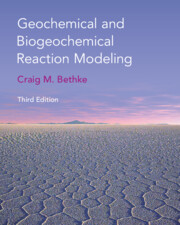Book contents
- Frontmatter
- Dedication
- Contents
- Preface
- Preface to Second Edition
- Preface to First Edition
- A Note About Software
- 1 Introduction
- 2 Modeling Overview
- PART I EQUILIBRIUM IN NATURAL WATERS
- PART II REACTION PROCESSES
- PART III APPLIED REACTION MODELING
- 26 Hydrothermal Fluids
- 27 Geothermometry
- 28 Evaporation
- 29 Sediment Diagenesis
- 30 Kinetics ofWater–Rock Interaction
- 31 Weathering
- 32 Oxidation and Reduction
- 33 Waste InjectionWells
- 34 Petroleum Reservoirs
- 35 Acid Drainage
- 36 Contamination and Remediation
- 37 Microbial Communities
- Appendix A Sources of Modeling Software
- Appendix B Evaluating the HMW Activity Model
- Appendix C Minerals in the LLNL Database
- Appendix D Nonlinear Rate Laws
- References
- Index
30 - Kinetics ofWater–Rock Interaction
from PART III - APPLIED REACTION MODELING
Published online by Cambridge University Press: 09 December 2021
- Frontmatter
- Dedication
- Contents
- Preface
- Preface to Second Edition
- Preface to First Edition
- A Note About Software
- 1 Introduction
- 2 Modeling Overview
- PART I EQUILIBRIUM IN NATURAL WATERS
- PART II REACTION PROCESSES
- PART III APPLIED REACTION MODELING
- 26 Hydrothermal Fluids
- 27 Geothermometry
- 28 Evaporation
- 29 Sediment Diagenesis
- 30 Kinetics ofWater–Rock Interaction
- 31 Weathering
- 32 Oxidation and Reduction
- 33 Waste InjectionWells
- 34 Petroleum Reservoirs
- 35 Acid Drainage
- 36 Contamination and Remediation
- 37 Microbial Communities
- Appendix A Sources of Modeling Software
- Appendix B Evaluating the HMW Activity Model
- Appendix C Minerals in the LLNL Database
- Appendix D Nonlinear Rate Laws
- References
- Index
Summary
In this chapter we construct multicomponent chemical reaction models of how an aqueous fluid might react with the minerals it contacts, according to kinetic rate laws. We show that the fluid can be in equilibrium or disequilibrium with respect to the minerals, and how the fluid chemistry can approach an apparent equilibrium that is in fact a steady state, rather than a thermodynamic equilibrium. We further construct example calculations that demonstrate the basis of Ostwald’s step rule and the nature of the incongruent dissolution of albite feldspar.
Keywords
- Type
- Chapter
- Information
- Geochemical and Biogeochemical Reaction Modeling , pp. 371 - 384Publisher: Cambridge University PressPrint publication year: 2022

